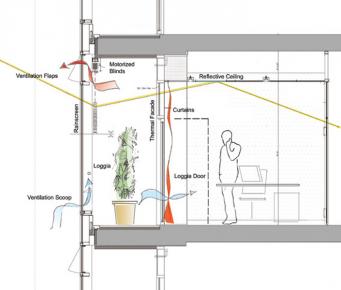Light collection [059]
Many buildings need to capture light from outside and take it to the most distant areas from the façade, but it is difficult avoiding glare and excessive input of thermal energy. Many architects are concerned to develop solutions in which the reflection of sunlight is brought to the bottom of the space.
This is not a new issue. In the narrow streets of the old town of Barcelona, there were some boards lined on the inside with reflective metal sheets, which were tilted down outwards to reflect the narrow light strip perceived at the top of the street. Also the concern to avoid glare is taken into account in careful curtains in many ground floors, which allow the entrance of light through the top of the window while protecting the privacy on the eye level. Gaudí at the Pedrera also studied how to introduce light without opening the entire opening using two roller shutters.
In contemporary architecture the most widely used solution is the provision of a horizontal plane situated at the top of the window, which reflects the light towards a more or less reflective ceiling which leads the light to the back of the room. Under the horizontal plane, the opening can have various forms of solar protection while the upper part remains always open to light.
In some cases the devices are magnified, as these pivoting and retractable louvers by Herzog or these reflectors on an inner courtyard of a Research Center in Cambridge.
Reflection can also have a more playful design or objectives of the internal space, as these mirrors to see the sea of Stockholm or these lunettes of a school in Zaragoza.
Some products begin to try to solve the contradiction between light collection, solar protection and glare; as this venetian blind, which can be oriented at different degrees by groups according to their height.



![/photo/light-collectors-barcelona-old-town-129 Link: Light collectors in Barcelona old town [129]](https://www.filt3rs.net/sites/default/files/styles/entity_ref/public/study/light%20129%20-%20light%20collection%20reflection%20reflexi%C3%B3n%20captaci%C3%B3n%20luz%20solar%20espejo%20mirror%20effect.jpg?itok=b5q0TPpF)
![/case/light-and-privacy-la-pedrera-gaudi-581 Link: Light and privacy in la Pedrera, by Gaudí [581]](https://www.filt3rs.net/sites/default/files/styles/entity_ref/public/study/light%20581%20-%20light%20collection%20reflection%20reflexi%C3%B3n%20captaci%C3%B3n%20luz%20solar%20espejo%20mirror%20effect.jpg?itok=PX97U0gr)
![/case/big-louvers-light-reflector-wiesbaden-thomas-herzog-047 Link: Big louvers as light reflector in Wiesbaden, by Thomas Herzog [047]](https://www.filt3rs.net/sites/default/files/styles/entity_ref/public/study/light%20047%20-%20light%20collection%20reflection%20reflexi%C3%B3n%20captaci%C3%B3n%20luz%20solar%20espejo%20mirror%20effect.jpg?itok=PHUkvMHX)
![/case/mobile-reflective-panel-illuminating-inner-offices-518 Link: Mobile reflective panel illuminating inner offices [518]](https://www.filt3rs.net/sites/default/files/styles/entity_ref/public/study/light%20518%20-%20light%20collection%20reflection%20reflexi%C3%B3n%20captaci%C3%B3n%20luz%20solar%20espejo%20mirror%20effect.jpg?itok=xq78TwEC)
![/case/wooden-lattice-and-light-reflection-zaragoza-423 Link: Wooden lattice and light reflection in Zaragoza [423]](https://www.filt3rs.net/sites/default/files/styles/entity_ref/public/study/light%20423%20-%20light%20collection%20reflection%20reflexi%C3%B3n%20captaci%C3%B3n%20luz%20solar%20espejo%20mirror%20effect.jpg?itok=qv1B1AjF)
![/case/208-trespa-reflector Link: [208]](https://www.filt3rs.net/sites/default/files/styles/entity_ref/public/study/light%20208%20-%20light%20collection%20reflection%20reflexi%C3%B3n%20captaci%C3%B3n%20luz%20solar%20espejo%20mirror%20effect.jpg?itok=13I9f9hW)
![/case/green-building-cambridge-560 Link: A green building in Cambridge [560]](https://www.filt3rs.net/sites/default/files/styles/entity_ref/public/study/light%20560%20-%20light%20collection%20reflection%20reflexi%C3%B3n%20captaci%C3%B3n%20luz%20solar%20espejo%20mirror%20effect.jpg?itok=V805ddul)
![/case/fragmented-enclosure-566 Link: A fragmented enclosure [566]](https://www.filt3rs.net/sites/default/files/styles/entity_ref/public/study/light%20566%20-%20light%20collection%20reflection%20reflexi%C3%B3n%20captaci%C3%B3n%20luz%20solar%20espejo%20mirror%20effect.jpg?itok=eQ3eVeHR)
![/photo/round-interior-solid-shutters-040 Link: Round interior solid shutters [040]](https://www.filt3rs.net/sites/default/files/styles/entity_ref/public/study/light%20040%20-%20light%20collection%20reflection%20reflexi%C3%B3n%20captaci%C3%B3n%20luz%20solar%20espejo%20mirror%20effect.jpg?itok=Rk_n6RZy)
![/photo/reflector-and-rearview-shutter-stockholm-327 Link: Reflector and rearview shutter in Stockholm [327]](https://www.filt3rs.net/sites/default/files/styles/entity_ref/public/study/light%20327%20-%20light%20collection%20reflection%20reflexi%C3%B3n%20captaci%C3%B3n%20luz%20solar%20espejo%20mirror%20effect.jpg?itok=4otgK7MJ)
![/case/pivoting-venetian-blind-different-situations-238 Link: Pivoting venetian blind for different situations [238]](https://www.filt3rs.net/sites/default/files/styles/entity_ref/public/study/light%20238%20-%20light%20collection%20reflection%20reflexi%C3%B3n%20captaci%C3%B3n%20luz%20solar%20espejo%20mirror%20effect.jpg?itok=K6eI3c8_)